Part One: The first time I remember seeing Hanscom Park was at age 16. We had gotten there by car, many of us, having packed into Someone’s Mother’s Retired Old Boat. The large kind of gas guzzling cars that would be handed down from kid to kid in a family until it eventually died, burning out the oil-starved motor in some Nebraska snow drift. Do large families even have hand-me-down cars anymore? We all piled out, some dancing about the Clunker to cassette tape punk rock, some standing, lighting fresh cigarettes, coolly effected by the long drive from “way out” in West Omaha. Myself, I did not even know where I was. I had lived in Benson most of my life and although I had been to the Center Mall, frequented Ritchie’s Chicken and taken acting lessons at the Emmy Gifford Children’s Theater right up the way, I was all turned around that night. If you allow for the lengthy trip to West Omaha to “spend the night at my friend’s house”, followed by a raucous night of picking up everyone we knew (and didn’t know) who wanted to drive around and do next to nothing, only to end up down at Hanscom Park, well….I thought I might be in a uncharted part of town. Which suited me fine.
At some point we ran up the park hill, headed west and spilled out onto, what I now know was, 32nd Avenue. The houses of Field Club—they were just amazing. Of all shapes and sizes. I knew they were much different than my beloved Dundee but I wasn’t quite sure why. That late night walk amongst the houses of Field Club, arguing about which one was best, sprinkled with singing up and down Woolworth Avenue and later dancing on the steps of the Gerald R. Ford Birthsite and Gardens was like a teen wonderland. Years later, as an adult, I would find plenty of reasons to drag Mr. Cassette along on various real estate home viewings in this glorious part of town.
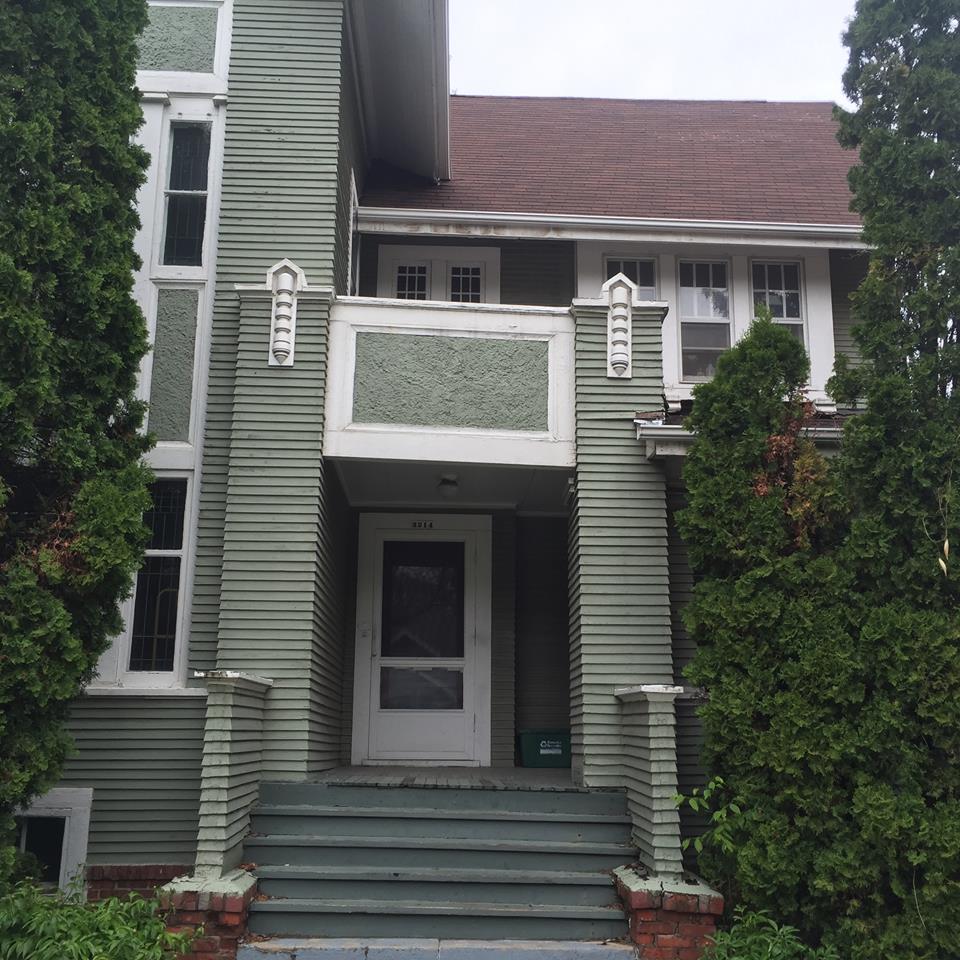
Not so long ago an old friend contacted me and said that his buddy had recently gotten a great deal on an older property in Field Club at 3214 Center. Apparently the new owner and his wife were working tirelessly on the house, doing all of the rehab work themselves, returning the home to its former glory. My friend then sent me some rather cryptic photos of the new owner unearthing an old fashioned furnace from the deep recesses of the home. I immediately asked if he could set up an introduction so I could get a better look for myself. Surely you now know how Miss Cassette can fixate.
 The furnace dug out of the basement floor.
The furnace dug out of the basement floor.
After I saw that gorgeous house for myself, I knew I would have to do a story on her history. With three floors, perfect woodwork throughout, the wrap-around porch of my dreams, the glorious windows, the nooks and crannies, pantries plus, a full sleeping porch, an uncertain sink in the third floor hallway, fireplace, built-ins and all of it, it was probably obvious I wanted 3214 Center Street for myself. There were odd little metal devices and mysterious wiring throughout the house. The icing on the cake was the children’s cabin in back yard, complete with a porch and a genuine, working, brick fireplace. I would truly have no inkling of the inherent beauty and inexplicable happenings of 3214 Center Street until much later.
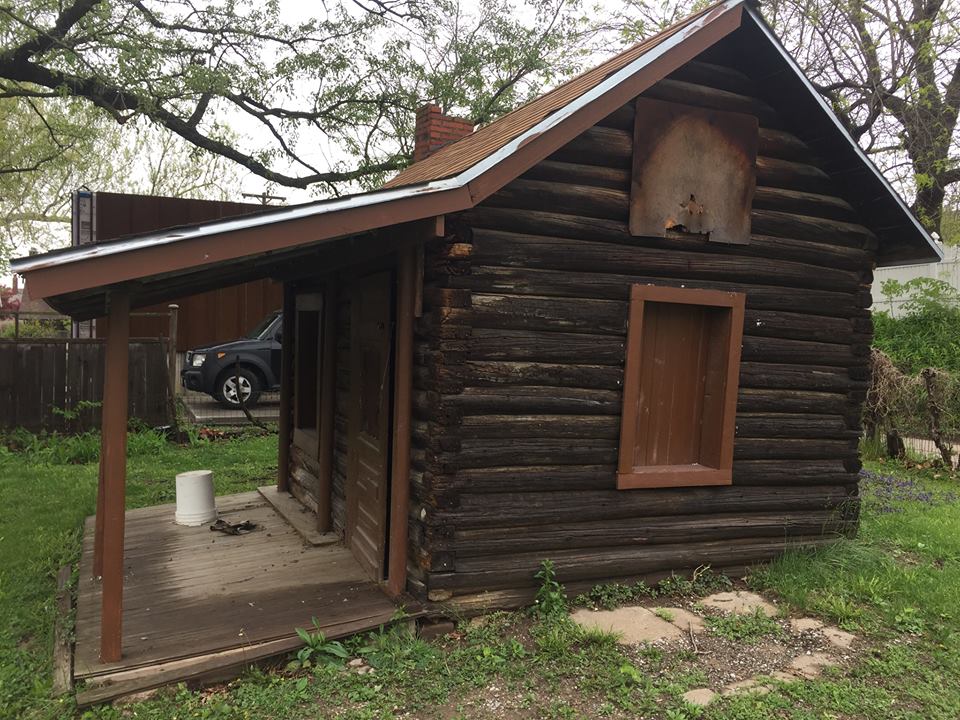
The children’s cabin playhouse in the back yard.
Background Information
I began digging for clues in full just a few days after. I wanted to know as much about the Field Club neighborhood and surrounding environs as I could. Living in Omaha we often have many things we think we know about our city that are oftentimes incorrect. I guess it is that way with everything. I knew I would need proper evidence so I headed to the library. Because of my early relation to Field Club by way of Hanscom Park, I was compelled to start there. The Hanscom Park perimeter is Woolworth Avenue, Park Avenue, Ed Creighton Avenue and 32nd Avenue. Although all avenues, I have always felt a very different energy on each of the four margins of that park. Have you noticed this phenomenon? Interestingly the land for Hanscom Park, near 32nd and Center, was donated to the city in 1873. Development plans weren’t made until 1889. It most certainly was not a coincidence that the oldest home of the Field Club neighborhood was built in that very year, bordering the park, facing east on 32nd Avenue.

Many more incredible houses were to be built with the final date of historic construction completed in 1949. From the Field Club National Register of Historic Places Report of 2000, I learned that the historic district boundaries of the Field Club neighborhood are Pacific Street, 32nd Avenue, Center St., and 36th Street. 36 Street also provides as border for Omaha’s oldest country club and golf course, Field Club of Omaha. As I have long thought, the little neighborhood is perfectly nestled in and hidden from view. For more historical information on this incredible neighborhood, please check out: http://www.nebraskahistory.org/histpres/nebraska/douglas/DO09-Field-Club-HD.pdf
I noted that 3214 was situated in the Edward Place subdivision. The National Register report designated 3214 Center as a home of historic significance, even featuring it in a photo. It was denoted as the C. M. Pennell Residence.

Photo from the National Register of Historic Places Registration Form: Field Club report. 2000. Photographer: Melissa Dirr.
Through the Douglas County Assessor I found the build date listed as 1910. The County Assessor along with other online real estate searches hinted at some confusing details of 3214 Center. The home sold for $88,000 on Mar 3, 2016. (That really was a great deal.) It was listed at four bedrooms, one bath, (odd, I thought as I personally saw two working toilets in the basement alone) and approximately 2,086 square feet. There are three stories with an attic.
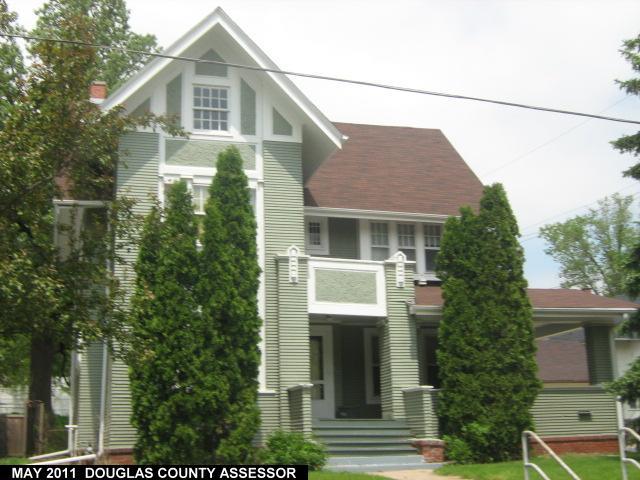
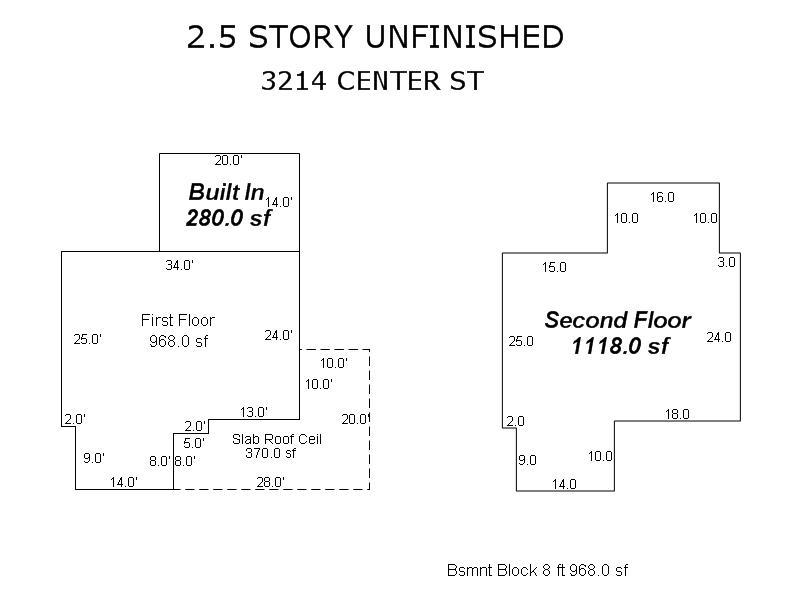
Douglas County assessor photos.
The property lot size is 7,500 sqft. I was puzzled by the queer little alleyway-driveway that turns into the property. This alley is shared with a number of neighbors. As it turns out one of the homes that Mr. Cassette and I looked at (read: dragged a poor realtor around by the collar for a whole summer) was catty corner from 3214 and shared that very alley. It was strange to become aware of having stood in that opposing lot, looking across the way, as I would likewise do years later from 3214. Anyway, I chalked that alleyway up to just one of a gazillion midtown quirks that makes old Omaha wonderful. Mr. Cassette estimated the Arborvitae growing in front of 3214 Center Street to be about 20 years old
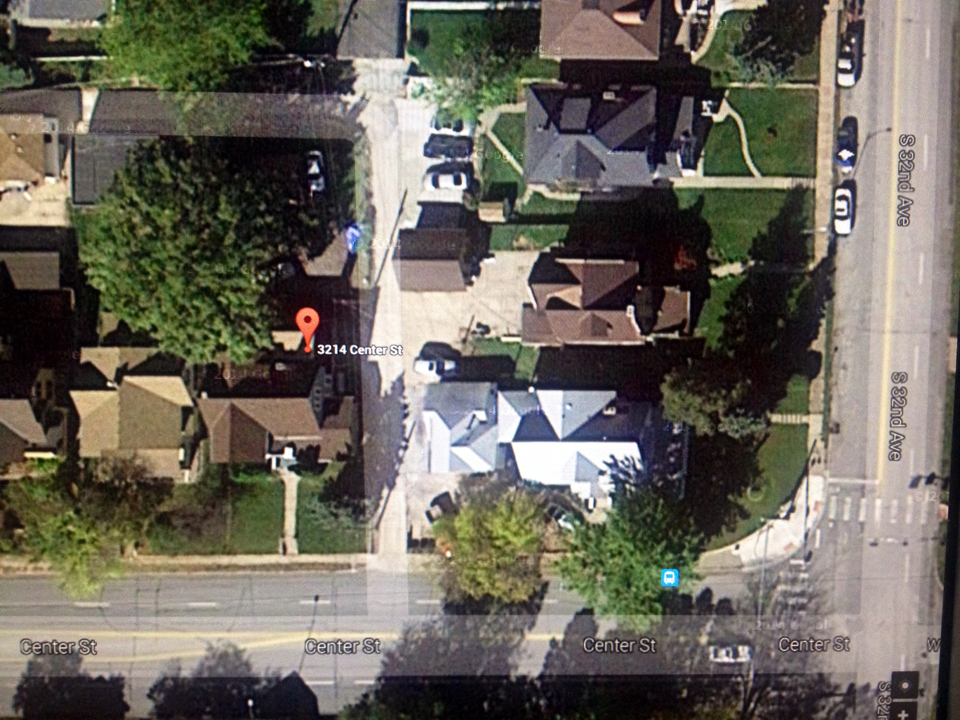
PHOTO: Aerial view of 3214 Center, illustrating the alley situation.
Historical Ties
These clues served as indication that I would have to reach out to Trina Westman, of the Omaha City Planning Department. She was kind enough to send some information from their database. She made reference to the historic owner of 3214 Center Street address as C. M. Pennell as well. From her contributions to the puzzle I learned, the home was erected in April 30, 1909 and the architect was none other than Henninger. Once I read the name Henninger, I was more than excited. Frederick Henninger, commonly known as F. A. Henninger, was a leading architect in Omaha. He worked in town until his retirement in 1937. A number of his works are listed on the National Register of Historic Places. Check out my previous story, The Case of Napier’s Booterie and the Securities Building to find out more about F. A. Henninger. She included the following incredible photos, taken from a Reconnaissance survey of 1980.
 Reconnaissance survey of 1980.
Reconnaissance survey of 1980.
I found it interesting that the builder was listed as unknown and the original owner as Douglas Security Co. The architectural style was listed as: Stick/Eastlake.
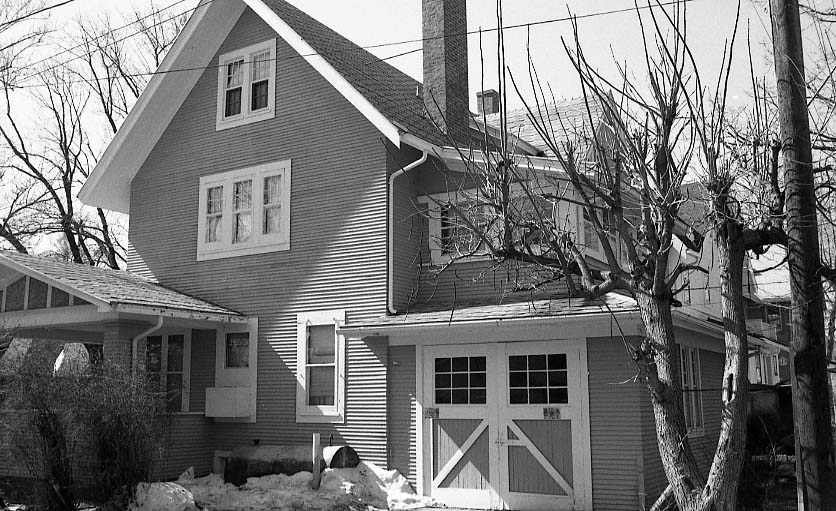
Reconnaissance survey of 1980.
There is a simple but great book called Identifying American Architecture by Blumenson, which I own, where I brushed up on the Eastern Stick style. A late-19th-century American architectural style, Eastern Stick is named for its use of linear, decorative “stick work” (overlay board strips) as horizontal siding. Asymmetrical in composition, steep pitched roof and the large porch of 3214 Center sealed the description for me. I was concerned about the Eastlake style, she had included. From another site I learned exceptionally stylized and decorative versions of the Stick style are often referred to as Eastlake. “Stick-Eastlake is a style term that uses details from the Eastlake Movement, started by Charles Eastlake, of decorative arts on Stick-style buildings. It is sometimes referred to as Victorian Stick, a variation of Stick and Eastlake styles.” I did not see how 3214 Center fit in the more decorative fusion style of Stick-Eastlake, save for the incredible entryway. But Miss Cassette has never claimed to be a student of architecture.

Reconnaissance survey of 1980
When I found 3214 Center listed in another one of my favorite books, 1980’s Inventory of Historic Omaha Buildings by Landmarks Inc., I knew I had a major leaguer structure on my hands. In 1978 the Omaha City Council passed an ordinance, which directed the Landmarks Heritage Preservation Commission to inventory all structures eligible for designation as landmarks. 3214 Center stands as one of the 1,000 structures identified by the Landmarks Commission for inclusion in this project as an example of Eastern Stick style from 1880-1910. The reconnaissance survey and photos were completed by Landmarks Inc. with the cooperation of Landmarks Heritage Preservation Commission.

Hanscom Park 1918. North west corner of 32nd Ave, across from the Ford Birthsite.
I reached out to Kristine Gerber of the incredible Restoration Exchange Omaha. She was so kind to go through their records but they did not have anything on 3214 Center Street.
M. Pennell Investigation
I speculated that C. M. Pennell was the original owner; after all isn’t that what “historic owner” might imply…. and yet, why the owner also listed as Douglas Security Co? Wasn’t that probably who financed the home? I found from other Field Club records that a number of houses around 3214 had Douglas Security Co. as original owner. I began to uncover bits of evidence about C. M. Pennell. I could find nothing about him being the original owner. What I did find pointed to him being the builder of the home. What I submit as proof: 1. An ad for Charles M. Pennell & Sons out of Council Bluffs, IA, alluding to contract work. 2. From the American Contractor (1918) Vol. 39 page 68, “C.M. Pennell CB, IA contracts awarded to district school” General Contractor let to C. M. Pennell of 703 Main Street. 3. “Store building at 415 W. Broadway Architect Henry J. Schneider—Gen Contr. C. M. Pennell & Sons of 703 S. Main Street.” 4. This ad looking for laborers to help build, what I theorize is, 3214 Center Street. This does not match the April 30, 1909 projected build date held by city planner’s records. Pennell & Sons quite possibly were building other houses in the area or the city could be off on their date.

Call for laborers, from August 2, 1909.
I surmised Charles M. Pennell was the building contractor of 3214 Center and not the owner. If he lived there, it was very brief at less than one year. He was a well-known long time resident of Council Bluffs, IA and likewise his business was on 703 Main Street in CB. I felt a real joy to discover a lead that C. M. Pennell was, at the very least, acquainted with J. M. Harding of Sealtest Ice Cream fame. I have often thought in the writing of these stories that at some point all of these Omaha characters will end up having known one another. It is coming true. See my previous essay Mysteries of Omaha: 5120 Mayberry Street for more about J. M. Harding (Jesse “Mac” McMillan Harding). The two were both pallbearers at John McDermott’s funeral. C. M. Pennell passed away in Council Bluffs in 1957 and his wife died previously in 1954.
Directory Clues
At this point, I knew my quest would lead to the city directories. The trouble came when I could not find any listing for 3214 Center. It was not visible in 1909, 1910, 1911, or 1912. I thought I was having another 2501 North 61st Street meltdown. Check out that story at Mysteries of Omaha:2501 North 61st Street. This led to a great scurrying in my brain, akin to our cats seeing a bird outside the window. Later I discovered an interesting bit of modification to Center Street. From the Omaha Chamber of Commerce Journal, “the origin of this street’s name is said to be obvious.” And yet Center Street changed to Lincoln Avenue in 1900 and later changed back to Center Street in 1916. You had better believe this gave me fits until I figured out those changes. Once I did, the amendment of Center Street became ever more intriguing to me.

Bedroom on the north side currently under rehab.
The First Family of 3214 Lincoln Avenue
There was no listing for 3214 Lincoln Avenue or 3214 Center Street in 1909. This can be explained by the newspaper article advertising for workers late in 1909. By 1910 I found the name H. Y. Readinger living in the Lincoln Ave address. From the ancestry site I learned in 1909, H. Y. Readinger and family had their residence at 2015 Maple Street. Mr. Readinger was secretary of the McCormick Coal Company. By 1911the directory had H. Y. Readinger listed as Harvey Y. Readinger, Secretary and Treasurer of the Edward Coal Company. This surely was a prominent position in those days. Further research in the Omaha World Herald pointed to the Edward Coal Company being housed at the old 537 Omaha First National Bank Building in its later years. I am not sure where the business was previous to the 1917 build date. Also through a genealogy site, I learned in 1910 Carrie Christensen, lived in the home as domestic help for the Readinger Family. Additionally in 1911 Peter Peterson, a painter, was taken in as a “b”, signifying “border.” I cannot be sure if he, too, was a servant or if he was a paying tenant. Why do I love this stuff?
Although Harvey Readinger was still listed as owning 3214 Lincoln Avenue in 1914, according to the city directory, I found a puzzling ad in the Omaha World Herald. It could be that he was trying to sell for some time and not having much luck.
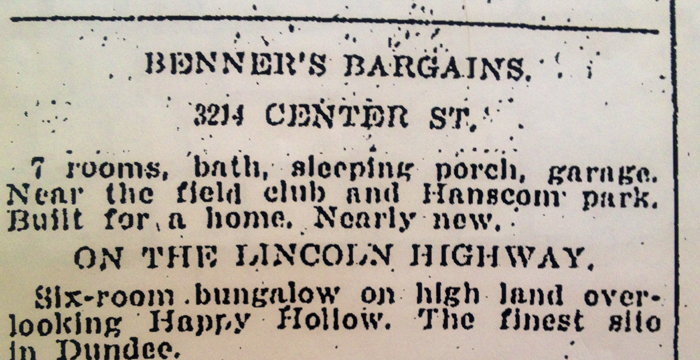
Dated October 18, 1914. The short ad lists the Center Street address and boasts all of the incredible characteristics of 3214. To include the sleeping porch and garage, which I thought for sure had been added at a later date. I think the wording of “Built for a home” is illuminating, as so many row houses and rooming houses were being built in this time period.
By all accounts, Harvey Readinger and family lived in the home throughout 1916. In this year, the home became listed formally as 3214 Center Street and Lincoln Avenue was no more. In March of 1916, an ad announces “owner leaving the city and lists his house.” The Readinger family was obviously moving on.

March 5, 1916 $75 a month rent
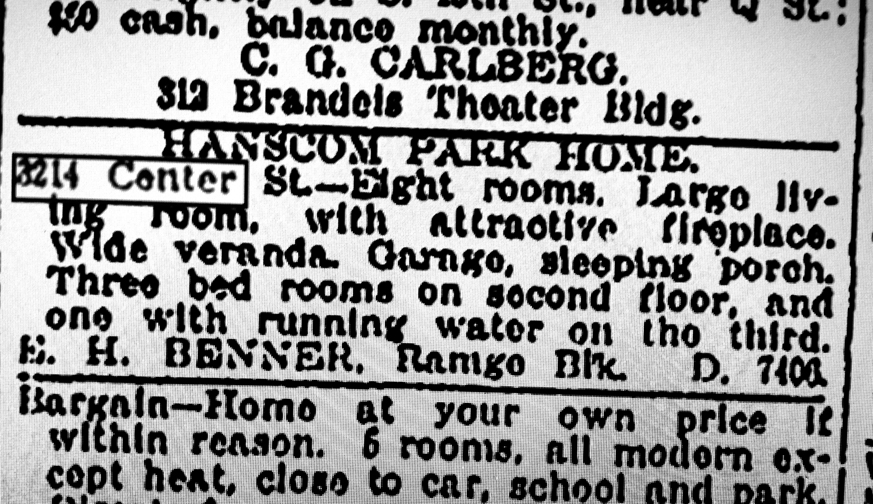
PHOTO March 26, 1916 “Hanscom Park Home” OWH ad “three bedrooms on second floor, and one with running water on the third.” I imagined the servant’s quarters must have been on the third floor with that mysterious sink in the hallway.
At this point I was pretty much beside myself, as I knew I was on the track of a real, genuine Omaha mystery. It was in no sense time wasted. Why do we, who love old homes, like these stories so? Why do we look for them? Does this hint at something deep in our grain?
Brief New Owner
In 1917 W. C. Bailey made 3214 Center his residence. In this same year, Clyde F. Bailey was listed as a boarder. I would guess that this was an adult relative, perhaps his son or brother. Upon further inspection, I located W.C.’s name and occupation. Willard Bailey was a local contractor. His office was in the 433 Ramge Building. From the 1920 Grain and Farm Service Centers Journal, Volume 44, I found this ad for Bailey’s business.

This pointer lets us know that Bailey was in business of building grain elevators. No small task.

Adorable third floor bedroom. Servant’s quarters? The sink is in the hallway right outside.
An Established Residence
The very next year, 1918, C. W. Pearsall took ownership. In researching C. W. Pearsall, I found from a July 10, 1909 snippet, “Mr. and Mrs. Charles Pearsall gave a dinner at the Council Bluff Rowing Association Club. Miss Marion and Isabelle Pearsall entertained at dinner.” This tipped off a long history of newspaper articles outlining the Pearsall’s many social engagements and distinction within Omaha society. Charles W. Pearsall was a well respected and apparently very well liked Federal Court reporter and secretary to Federal Judge Woodrough. His daughters Marion, Isabelle and Ann Louise “Sunny” Pearsall were mentioned often in the press for their involvement in community affairs and parties. In one darling article, Ann Louise “Sunny” Pearsall is highlighted because of her name—“Called Sunny or Sunshine, formally, for her disposition.” Charles Pearsall’s wife, always called Mrs. Charles W. Pearsall, held many small events in her home. This was in the day of women’s card games and tea parties making big news. By all appearances it was a very lively household.
In September of 1923, there appeared a small article describing the Pearsalls’ return from a no doubt, relaxing, Okoboji weekend. This is the first time that I noted the Goodrich name used in connection with the Pearsall name. Put that bit of info in your pocket and we’ll revisit this later.

Sept 12, 1923 Okoboji Weekend
String of Deaths
I was surprised to come across an obituary for James Pearsall from April of 1928. I hadn’t previously found his name in all of my recent fervor. James Pearsall, age 86, the father of Charles W., had been a long time contractor out in Columbus, NE. The elder Pearsall had been born in Canada and settled in Nebraska in 1873. Seven years earlier, upon retirement he moved in with his son, Charles W. and his family. The elder Pearsall’s wife lived in the home also. James Pearsall died in 3214 Center Street and the family held his funeral service in the home as well. Most people died at home during this period and it would have been common for a family to have a funeral or wake in their living room. I imagined the spacious front room of 3214 all decked out for a funeral.

Lovely upstairs bedroom light fixture. Taped off for work being done.
Throughout the early 1930’s I found multiple ads run for “Springer Spaniel puppies for sale ‘thoroughbred’. Springer Spaniels seemed like just the appropriate breed of dog to inhabit 3214 Center Street. English Proper but not too big for their britches. I could imagine the excitement of puppies running up and down all of those many wooden stairs. Of significance there is also a “1930” written in the concrete outside of the garage. The new owner and myself thought that must have meant the garage and sleeping porch were built at that time, as an addition. Because of previous real estate ads, you readers now know this cannot be the case. I am going to theorize that the garage floor was poured in 1930.

1930
The OWH ran a most unusual article, dated July 8, 1931. It was much too long to scan for this essay so I will attempt to capture it. Ann Louise “Sunny” Pearsall (listed at this time as an assistant advertising director of a department store) and her father Charles W. unfortunately found Sunny’s fiancé dead in his home. C. Wayne Calhoun, 26, of Chicago was a telephone company employee. When Calhoun did not meet Sunny for lunch, she began “to fear he had met with an accident in his car and might be lying helpless at home or in the hospital.” Apparently he had left the stove on and the coroner reported he suffocated from lack of oxygen consumed by the burning stove. Sunny “offered an accident theory” that Calhoun had lit all of the stove burners to warm the chilly kitchen. The descriptions alone were chilling me in this article. You don’t often see writing like this in 2016. The article was titled, “Youth is Found Dead at Home by Fiance. Gas Burning, Oxygen Gone, Girl Holds Accident Theory.” The detective in me found it odd that Sunny had asked her father to accompany her to her fiancé’s home. No matter what my suspicions are, this would have been a tremendously difficult death to accept as a young fiancé.

West side of unfinished attic. The new owners are creating a master suite.
On April 18, 1932 Charles Pearsall, the well-known Federal Court reported died. His funeral services were conducted at All Saints church. One month later on May 17, 1932, his mother, Mrs. Isabella Gonsalus Pearsall, 90 years old, died suddenly because of an infection. Her death certificate and large OWH write up state that she died in her daughter-in-law’s home at 3214 Center.
The Goodrich Connection
I had asked you to remember the family name Goodrich. This is where the story gets a bit more complicated. The city directory of 1932 has both J. Emerson Goodrich Family and C. W. Pearsall family listed as owning 3214 Center. I had wondered if Mrs. Charles Pearsall was a Goodrich, if there was some other family thread or if they were just great friends. I knew I had to track down more information about the Goodrichs. From Omaha: The Gate City, and Douglas County, Nebraska, Volume 2, (very near the Bible of Early Omaha) I found the history of the Goodrichs. Joel E. Goodrich, the family head is featured prominently in the book including a large photo. This book only featured the most prestigious, influential characters of early Omaha. So, yes, I was understandably impressed as should you be. Joel E. Goodrich married Mabel Mooney and proceeded to make millions of dollars from his Velvetina invention and later the formation of the Goodrich Drug Company. Orla, Howard, J. Emerson, all of his sons worked for the Goodrich Drug Co. The couple had a daughter, Helen who died early at age 20.

The Goodrich Drug Co. was big business in Omaha from 1904 until 1934. I found all different company hierarchical clusterings of the father and his sons. The business later became the Goodrich Cosmetic Co., and only J. Emerson (son) was listed. Mysteriously according to Fike, by 1916 the company name had changed to the Velvetina Co. Inc. Fike also indicated that the product, Velvetina, was still being advertised as late as 1942. I found the Goodrich Cosmetic Company address from a number of great ads looking for beautiful, young saleswomen. The company was housed both a cosmetic shop and their laboratories at 1114 Farnam. This building is no longer in existence. I suppose this would have been just south of the Gene Leahy Mall, approximately where the Club Irie is located.

Goodrich’s product Velvetina. Purportedly a hair tonic for treating dandruff, scalp disease and falling out of the hair. Interesting to note the Goodrich Drug C. is advertised as a perfumer. I LOVE this bottle and the box is even more divine. Such a beautiful product. No wonder they made millions!

Antique wallpaper
So what does all of this mean? From the looks of things, Mrs. Ann Pearsall (finally her first name is given out), widow of Charles Pearsall and Mabel Goodrich, then widow of Joel E.Goodrich cohabitated as well as co-owned 3214. It is peculiar how the names changed off and on through the years. From a couple of genealogy sites, I became aware of many family and servants living in the home during those years as well. 1933 listed Mrs. Ann Pearsall sole possessor. Alice Jivorksy was a live in maid. An OWH article of November 11, 1934 announced, “Sermo Club, Tuesday in the home of Mrs. J. E. Goodrich, 3214 Center Street.”

Formal coat closet window.
Why was I so happy to find that “Miss Pearsall Weds Today” in an article dated August 24, 1934? In getting to peer into these people’s lives and follow their stories, a compassion and interest grows within me. Am I alone in that? I have to say, I was worried about dear Sunny. Apparently she married a fellow named R. W. Sharp from Cleveland. I’ve just got to share this because, as you might know, I love, love, love my vintage clothes—another obsession. If you are not interested in fashion, read on, by all means. We will catch up later. Listen to this–For a 1934 August wedding, our dear Sunny wore “all black. The dress, fashioned with skirt and jacket is of silk crepe and the blouse of black satin, all severely tailored. The collarless jacket had three-quarter sleeves and buttons up the back. The blouse collar turns over on the high neckline of the jacket. An oversized beret, black suede pumps and white gloves complete the costume, with which the bride carries a cluster of gardenias.” Why, I should say! My kind of gal.

Descending the main stairs.
1935 listed J. Emerson and his wife, Marian P. living in the home along with his mother, Mrs. J. E. “Mabel” Goodrich, homeowner. They employed Eleanor Kula, a domestic servant, who also lived in the house. Mind you, there are many colorful articles I have found on the sleuth’s trail of 3214 Center that I am not mentioning but since I have mentioned it, let me tell you about one from February 20 of 1935. A woman was driving her car by 40th and Center and fell out of it while attempting to shut her door, which had come open. A young couple found her and carried her through the snow and icy conditions to 3214 Center where she was given medical attention.

The dining room once the drop ceiling was removed, pre-rehab. Note the 1909 leaded glass windows. Dying.
In 1936 Arabella Goodrich, daughter of J. Emerson and Marian Goodrich, was listed as a “student” while living in the home. Her parents as well as her grandmother, Mabel Goodrich, continued to live there. Mrs. Charles Pearsall continued to rent the property off and on most summers during these years. I would imagine both families continued to summer in Lake Okoboji or who knows where. The Baer family from Iowa and their guests rented 3214 Center, visiting for the summer months. I couldn’t help but wonder if they were related to the Brandeis Baers.

Beautiful little light.
Mrs. Ann Pearsall was listed as homeowner in 1937. In 1938 Mrs. Ann L. Pearsall and J. Emerson Goodrich are both listed as holders. In an unexpected turn, Dorothy S. Goodrich (wife of Orla S. Goodrich, oldest son of the Goodrich empire) took possession from 1939 through 1941. Jack S. Goodrich, employed by the Union Pacific Rail Road also moved in. I believe Jack might have been Orla and Dorothy’s son. At this juncture I found vague information confirming what I had suspected. Ann Louise Pearsall, mother of Sunny and widow of Charles Pearsall was related to the Goodrichs. Maybe one of our reader friends will have more specific familial information about this.
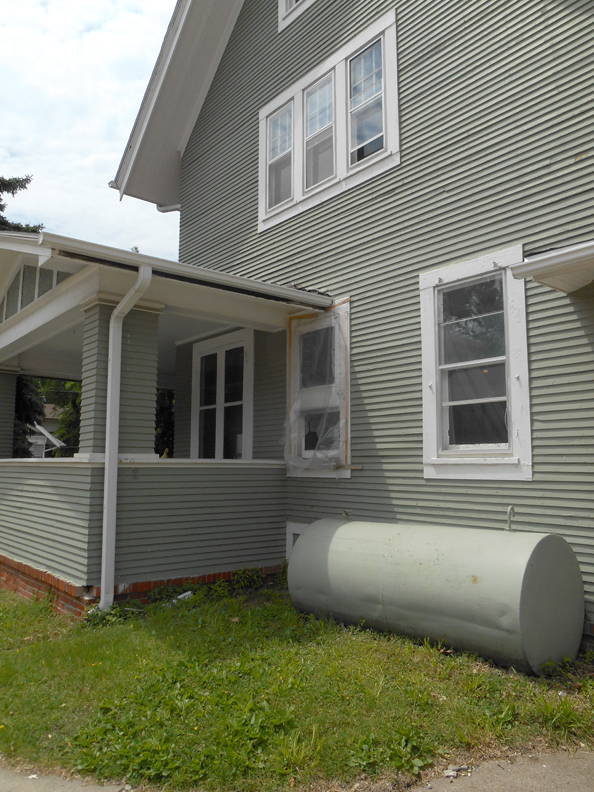
East side of the exterior.
New Family, New Evidence
1941 drew the arrival of a new proprietor: John P. McFarland and his wife, Ruth. According to the city directory, there were seven people living in the home that year. I located some history on the new owner and found John Patrick McFarland was a live stock director at the 835 Live Stock Office Building. This was a prestigious appointment. It would later be called the 826 Livestock Exchange Building. October 6, 1944 there was a birth listed at 3214 Center for a William, Patricia Wickham. I would guess that this was a domestic worker. A couple that lived in service at the home, Eugene and Mary Jean Ingold, also gave birth to a child on November 1, 1944. This must have been a very lively household as well. I found great evidence that John P. McFarland and Terry McFarland (son?) liked fast cars. There were a number of speeding tickets under this household address. Many. Like a lot. Who could blame those McFarlands, though, with those powerful, big cars of the late 40’s and 50’s? The family continued to inhabit the dwelling until 1954.
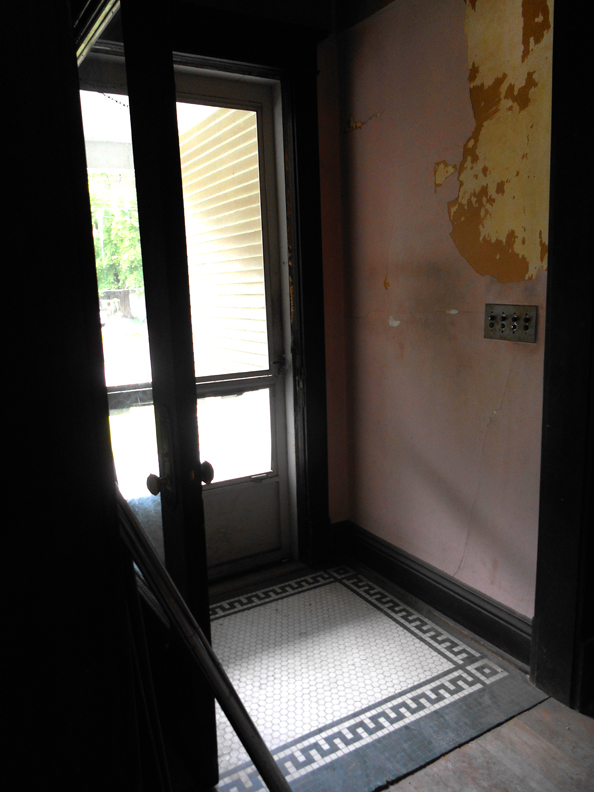
Entryway with tile work and push button light switch.
A Series of Short Ownerships
Robert F. Gillard, his wife, Patricia and their two children moved in to our Field Club fascination in 1954. Gillard was a representative of the Highway Motor Freight Inc. I found Highway Motor Freight Inc. had its business down at 1023 Davenport St. This is currently in no man’s land, basically the Century Link south parking lot. 1955 welcomed John H. Combs and his wife, Elaine D. to the property. Combs was a veteran of the United States Air Force. They only stayed in the home for two years until they pulled up stakes. By 1957 Edgar W. Nichols and wife Kath. C. relocated to the home on Center. Nichols also was a veteran, serving in the United States Air Force. These military families might have had short stays due to their service obligations.
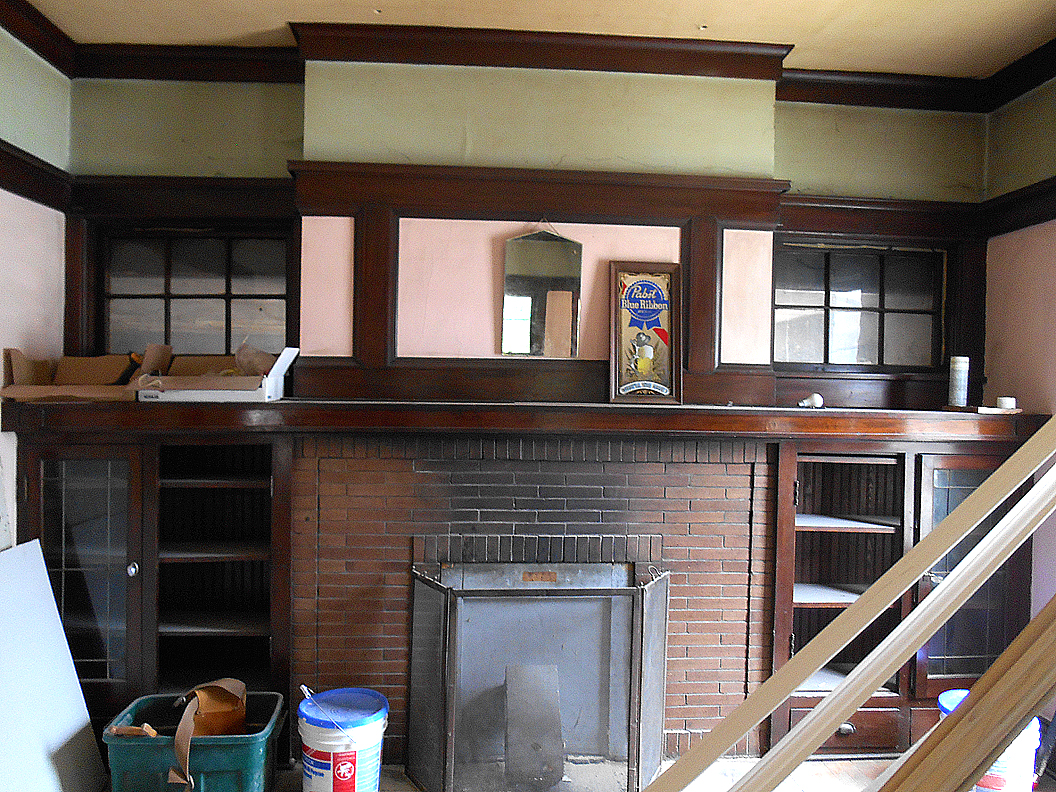
The living room. The windows bookending the mantle look out into the garage. The green part of the wall was previously hidden by the drop ceiling, recently removed.
The beautiful, once full the brim, house at 3214 Center stood empty for most of 1960. I was able to track a number of real estate ads during this time with slight changes in wording, such as calling the sleeping porch a sunroom.
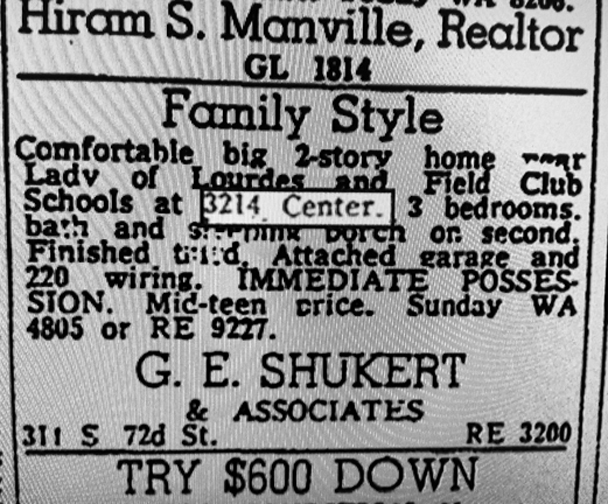
June 12, 1960 “Family Style.”
Another Family Calls 3214 Home
**Addendum of October 31, 2021** Out of respect for the family’s privacy, this portion of the home’s history has been removed.

Floor grate.
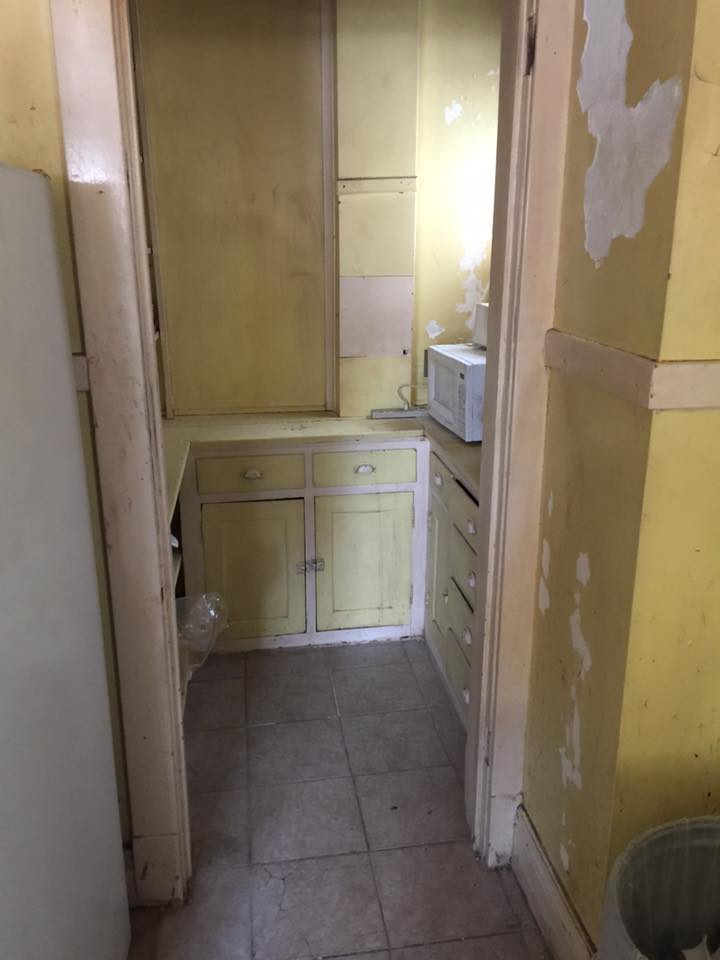
Kitchen pantry.
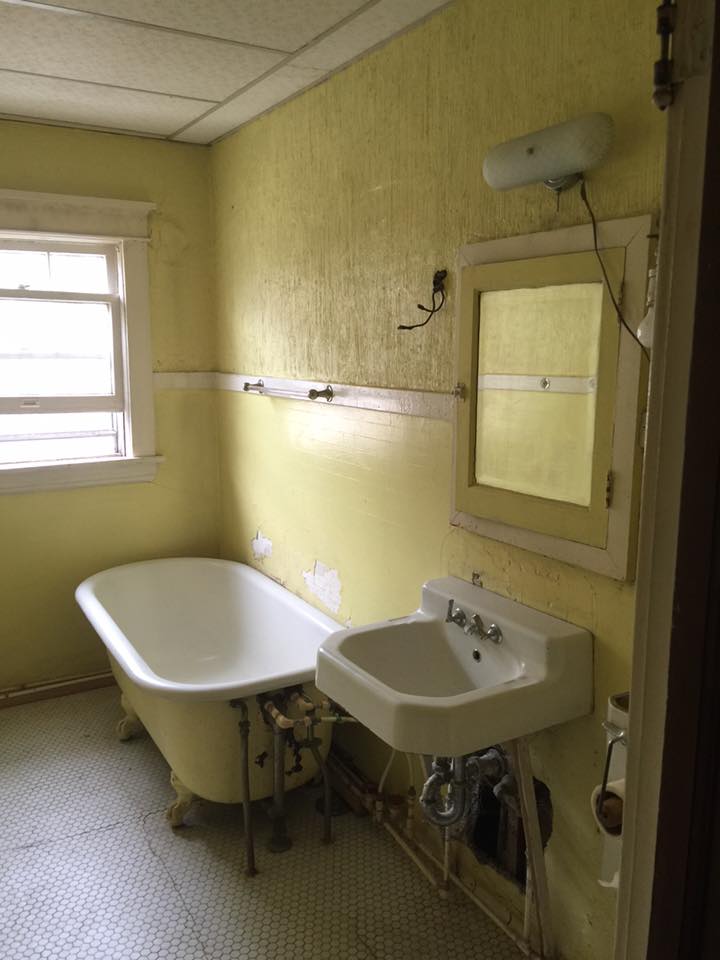

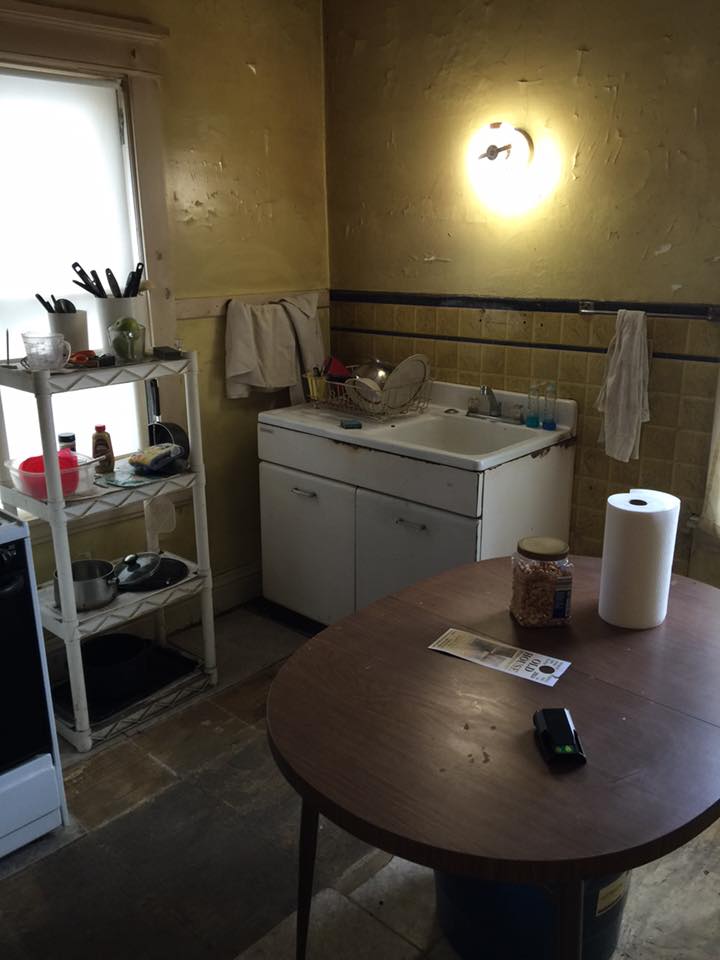

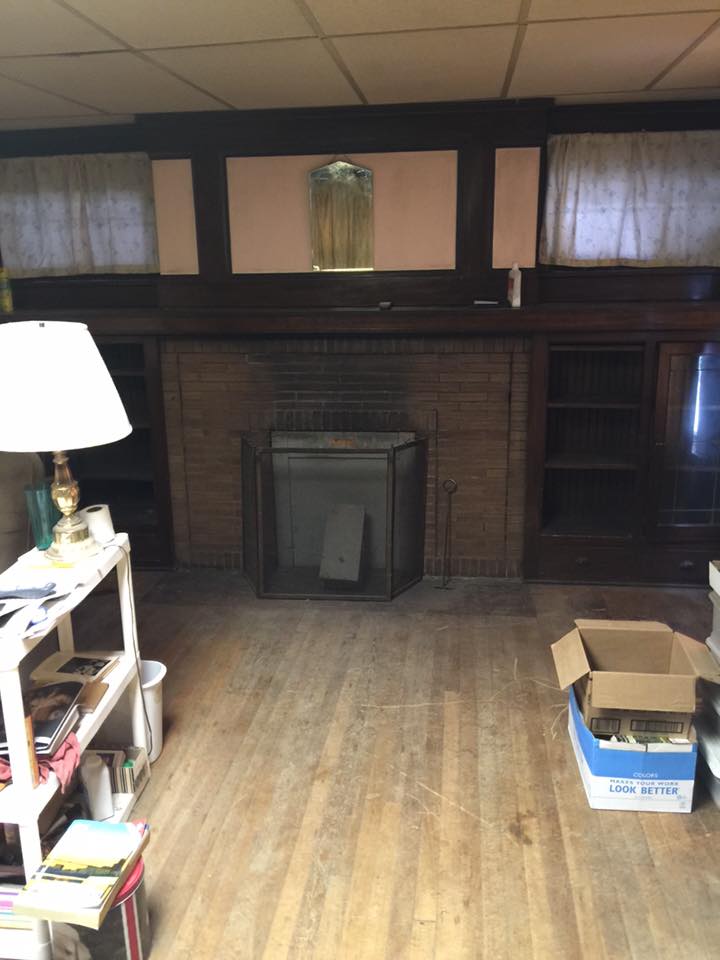


A New Start
Although 3214 Center had gorgeous bones, it appeared to the young couple touring the house for the first time, that there hadn’t been any work done in the home for fifty years. The new couple was not sure of the living conditions of the owners but the house itself was nothing short of amazing. They knew nothing of the historic nature of the house, just that it was their dream home. With a great deal of technical skill between the two of them, they wanted a project property they could work on together. They wanted an older house, made with quality materials, in an older neighborhood. This seemed like the perfect place at a low-ticket price of just under $88,000.
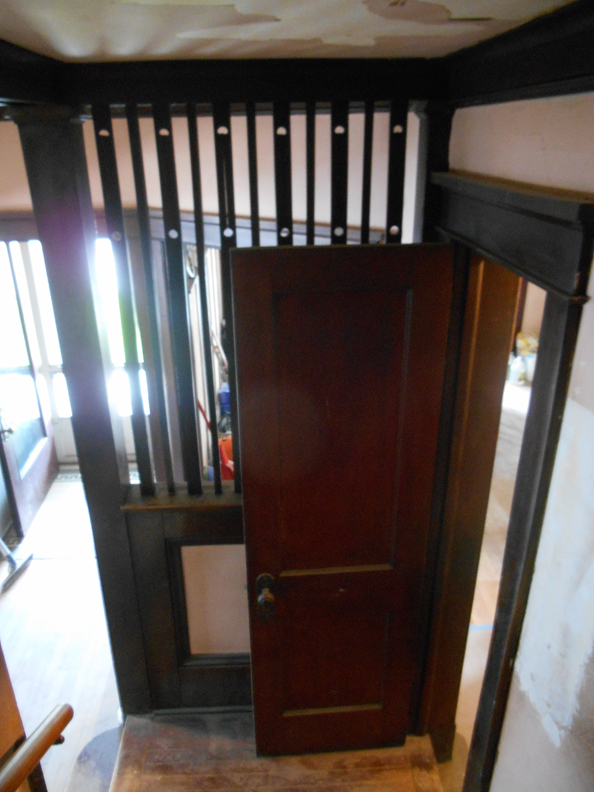
The new owners signed the papers and the deal was finalized. That very day, March 3, 2016, they were in the house beginning work.
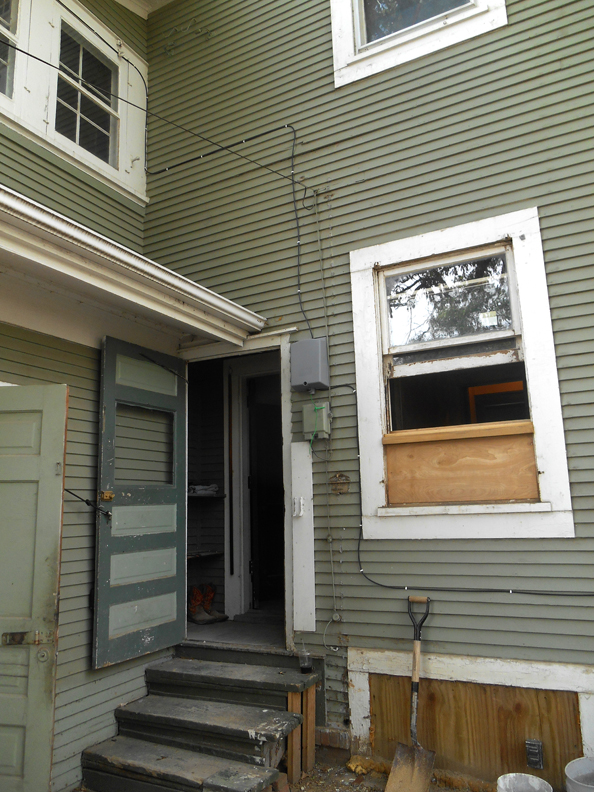
North side of house, pre-rehab.
Part Two: The New Family Digs In
Let me assure you that the young couple and their family are excited and have worked so very hard to create a bright and beautiful home, one that will allow 3214 Center to shine again. They’ve got a lot of work ahead. One of the first jobs was removing that drop ceiling which revealed a garish green paint atop the already pink walls. Right away they began working on the kitchen and bathrooms. They turned the first floor coat closet into an additional bathroom, creating an intricate wood design on the interior wall, mimicking the windows of the house. Gorgeous.
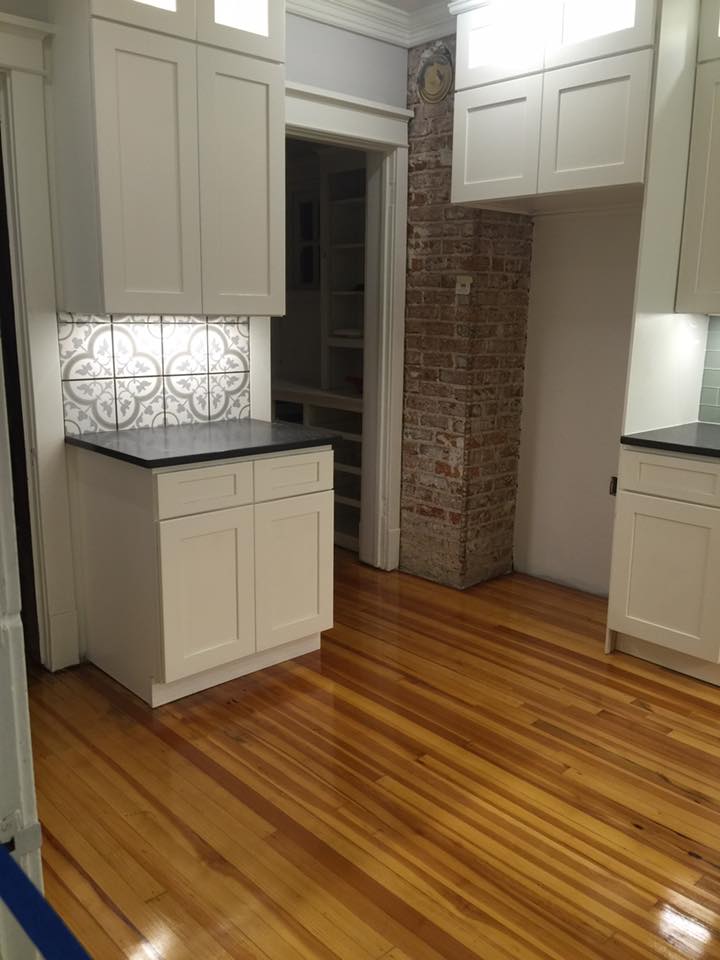
New kitchen, revealing the beautiful original floors under the tile. Encaustic tiling, new cabinets with exposed brick, doorway revealing new, cleaned pantry.
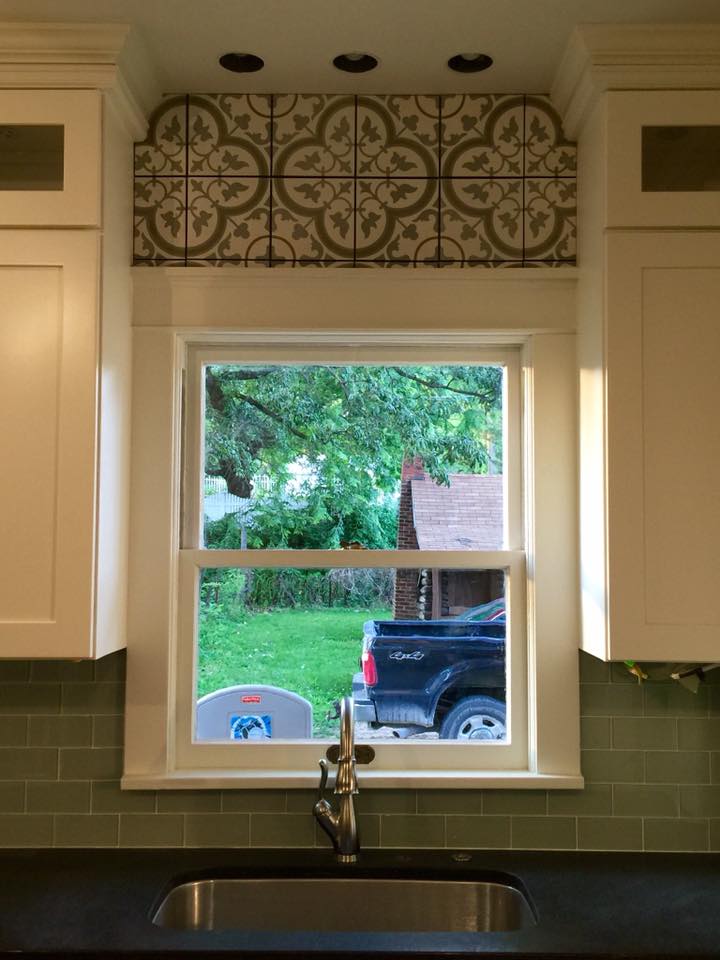
More encaustic tiles with all new touches. Notice the cabin in the back yard.

Love the original floor found under the tiles.
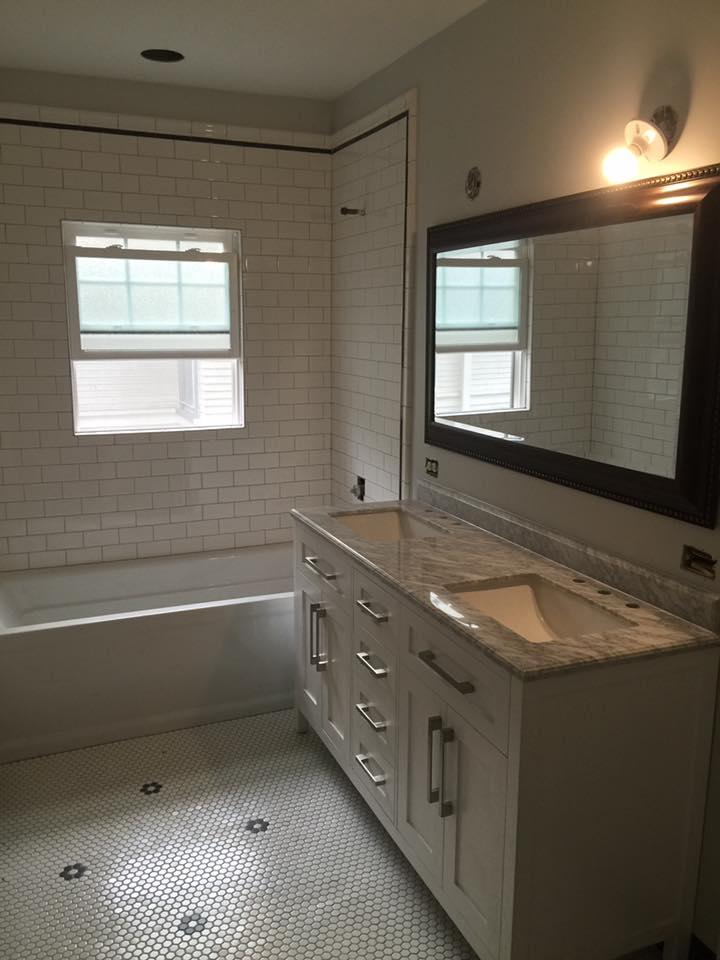
The beginnings of a new bathroom.

Hallway closet, gutted and ready to be made into a new first floor powder room.

The reconfigured first floor coat closet is now a powder room.
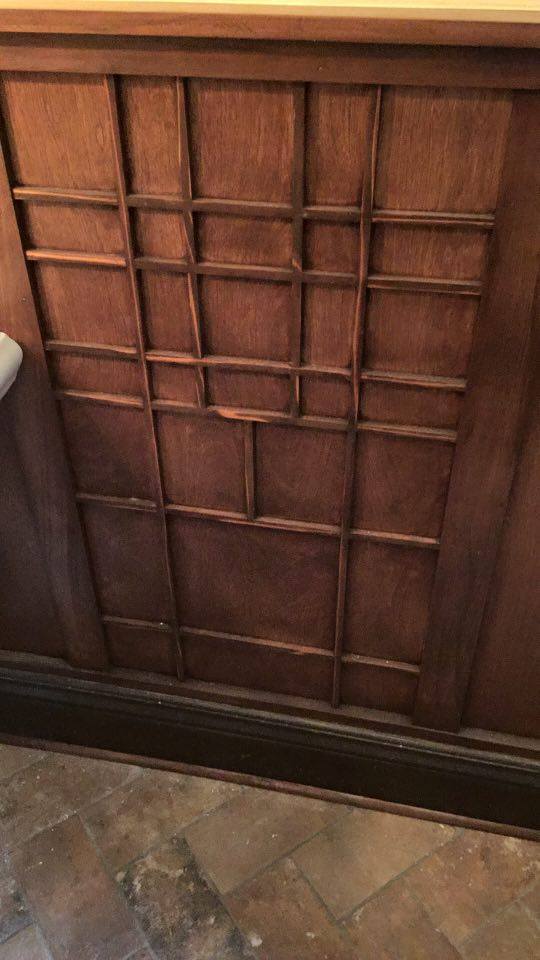
All woodworking craftsmanship found in the powder room created by the owner to mimic the early 1900’s leaded glass windows of the house.
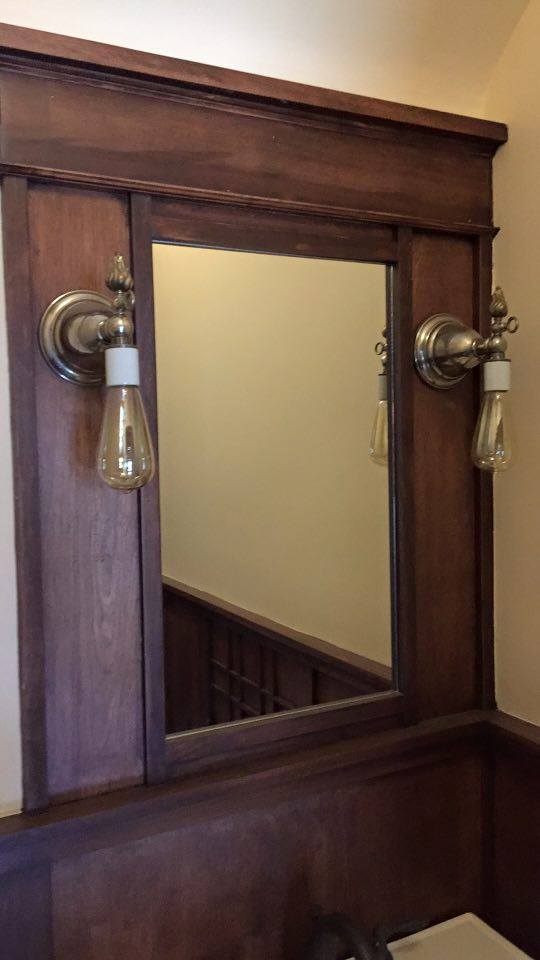
Powder room detail. More beautiful woodworking from the new owner.
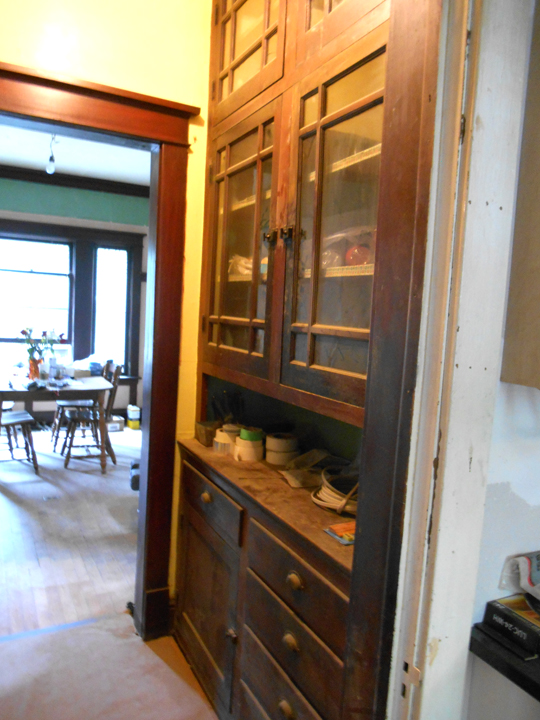
Butler’s pantry waiting to be stripped and re-stained.

Absolutely beautiful front bedroom. Those windows. More leaded glass windows. Also note the window in the closet.

This living room is going to glow again. The windows reveal the large warp-around porch.
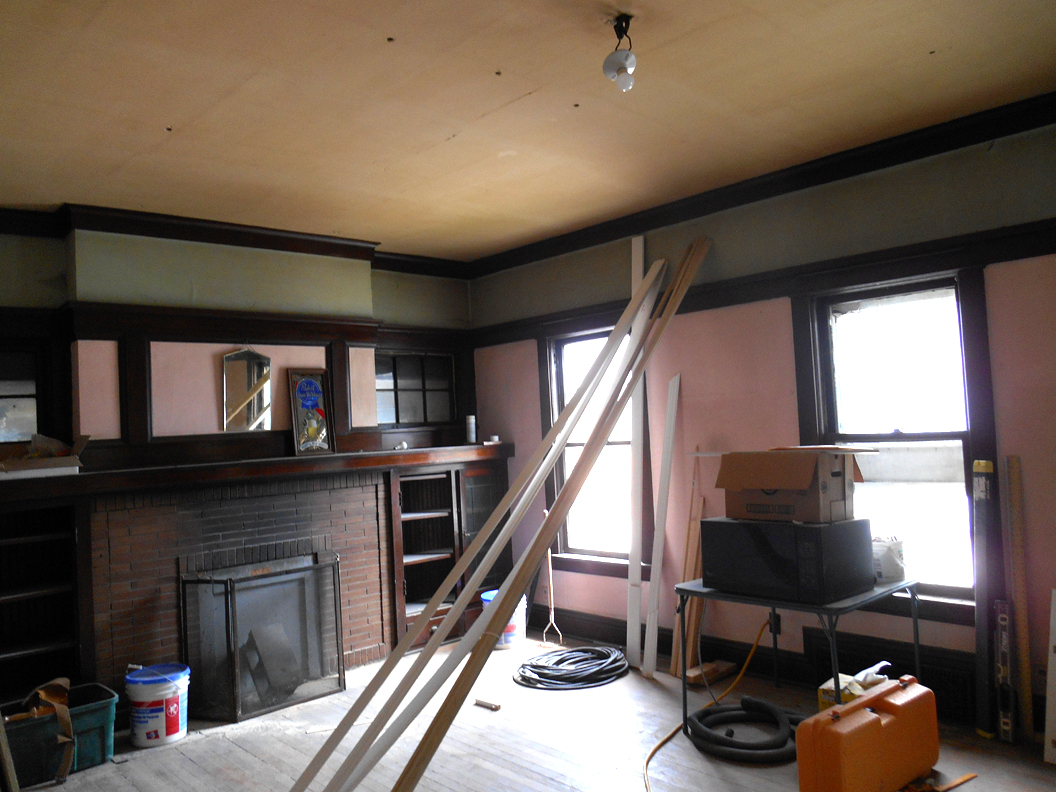
Part Three: My Favorite Features of 3214 Center Street

The Dictograph Mystery
One of the more curious things about the house are the little metal boxes found everywhere, complete with bizarre wiring. The boxes say “Dictogragh.” From Wiretapping and Electronic Surveillance in America, 1862-1920, I learned about the Dictograph. First mentioned in the media in 1906, Turner’s Dictograph was being developed as both an intercom and a bug.

Press to Test
There is a Dictograph in every single room of 3214 Center. Some are mounted near the ceiling. These boxes were a telephonic instrument for secretly monitoring or recording conversations by means of a small, sensitive, and often concealed microphone. The Dictograph was one of the early eavesdropping devices.
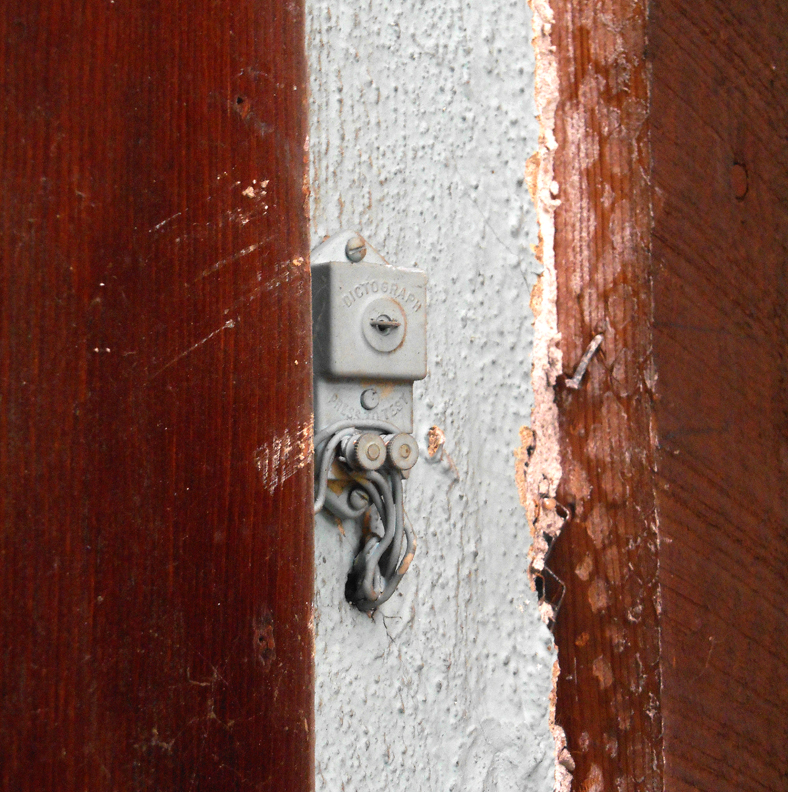
Most commonly used for business, government and “at-risk individuals.” Seeing as this was a single family home, save for a boarder or two, 3214 Center might have used the Dictograph as a servant call button or an intercom for the family. The Dictograph as a house intercom system became a huge and lasting success. Still, let me remind you that this intercom could also be used as their Detective Dictograph very easily. We have no idea which owner installed the intercom or bug, however you choose to look at it, but they remain in every room. To read more fascinating history on the Dictagraph, check out http://telephonecollecting.org/dictograph.html

Attic Dictograph wiring.
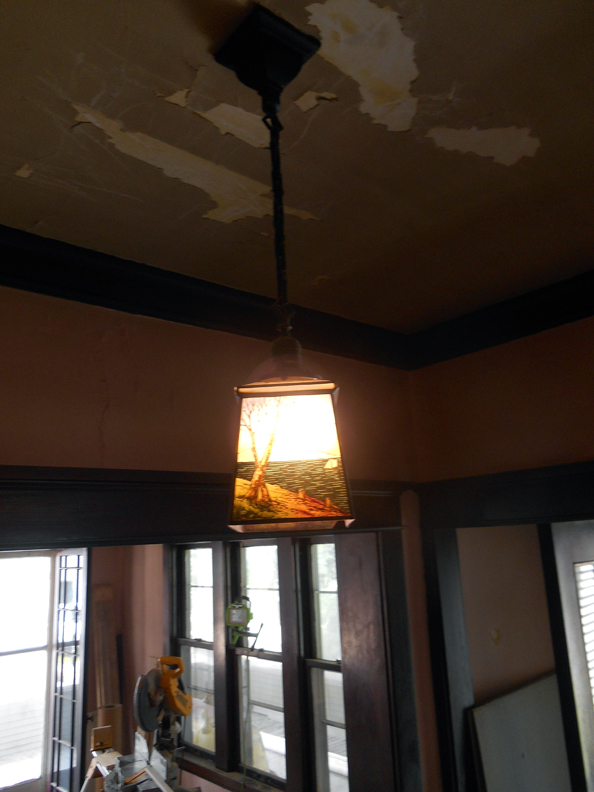
The Pendant Light
The glass pendant hallway light, hanging by a chain melts my heart. It is four-sided glass with river scene and tree. The image is distinguished for its use of heavy black line like the illustration in my grandmother’s childhood books. I could stare at that glass image forever. It has a warm amber, rustic feel.

The Sleeping Porch
I had heard of sleeping porches from my grandmother when I was a child. It immediately merged with my childhood desire to camp but byway of my own bed. Sleeping porches were popular at the turn of the 20th century, when health professionals began advocating for sleeping outdoors as a way to bolster the immune system. And prior to the advent of air conditioning, sleeping porches were especially popular when it was cooler to sleep outside at night. Sleeping porches were often featured in Queen Anne Victorians and Arts & Crafts-style homes. It was most common to find sleeping porches adjacent to second- or third-story bedrooms, located on a corner to receive breezes from all directions. The sleeping porch of 3214 Center has large windows on three sides boasting a neat little trick. All windows are “pocket windows”, like a pocket door that slides magically into the wall, or these are sometimes called a “hung sash window”, which has moveable frame panels of glass up or down into the walls to expose even more breeze. Delightful!

Very large sleeping porch, waiting for its renewal.
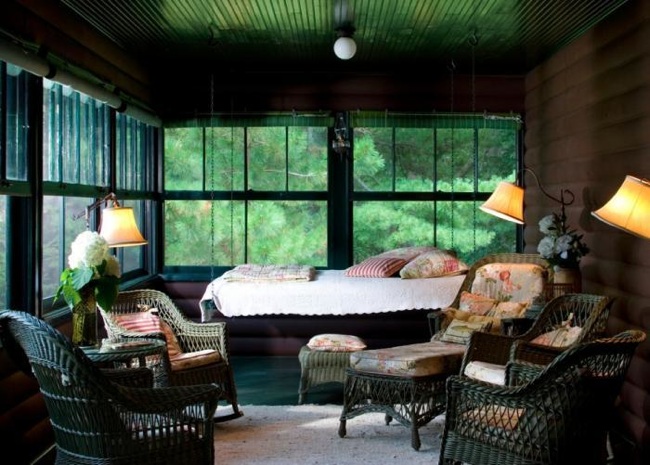
An example of an updated but fairly authentic sleeping porch, complete with hanging bed.
The Children’s Cabin
I have only ever seen anything remotely similar when my grandmother used to tell me of her family’s two playhouses from her childhood. I still treasure those photos of her siblings lined up in front of these small but detailed structures. Quite an elaborate building for a child’s playhouse, the 3214 Center Street cabin looked so very similar to my grandmother’s black and white photos from the early 1920’s. Even if this little cabin was built in the early 1960’s, I marveled at the attention to detail. Try as I might (I tried everything I know!), I could find nothing about the history of this cabin. Nothing. I was driving me mad. Could this wonderful cabin have been standing in the backyard since the house’s early days? Imagine the stories it could tell. Imagine the stories this whole house could tell. I’m going to listen a little closer when I drive past on Center Street next time.

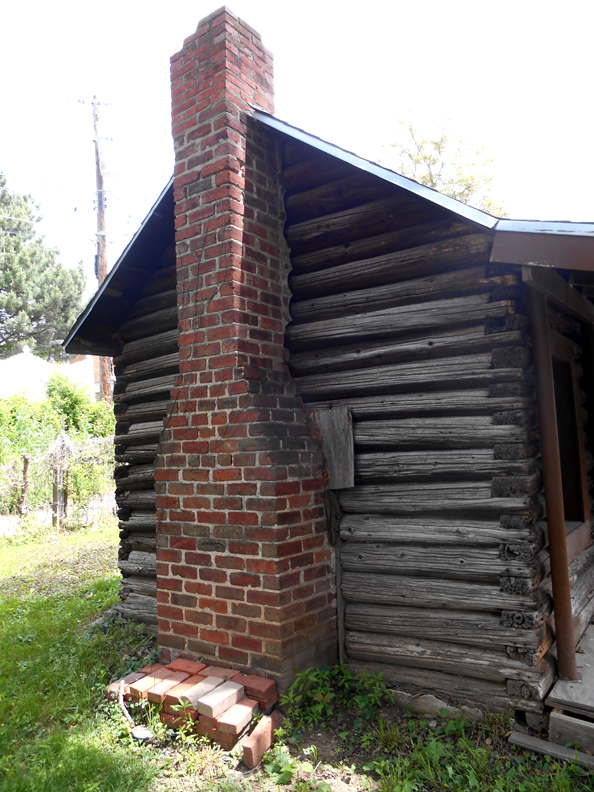


We now have an update on the cabin. Follow here for more news: Closer to 1916 South 32nd Avenue.
Thank you so much for reading this blog. I am have had a real blast getting to know the new owner and researching this great Field Club property. If you would like to comment on this story, please click on the header title. If you would like to email me privately, please do so at myomahaobsession@yahoo.com. The good news for anyone lusting after this historic children’s cabin is that it’s up for grabs. Please comment or email and we’ll get you in touch with the owner. Thank you, Omaha friends.
© Miss Cassette and myomahaobsession, 2016. Unauthorized use and/or duplication of this material without express and written permission from this site’s author and/or owner is strictly prohibited. Excerpts and links may be used, provided that full and clear credit is given to Miss Cassette and myomahaobsession with appropriate and specific direction to the original content.
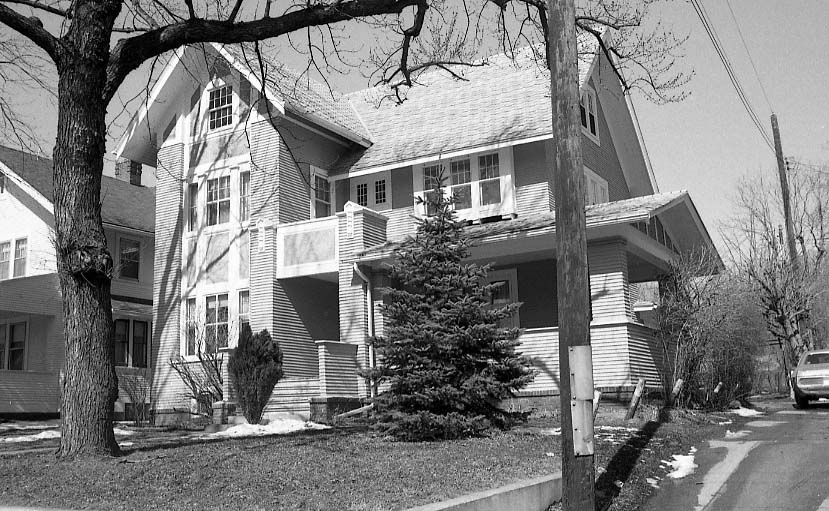

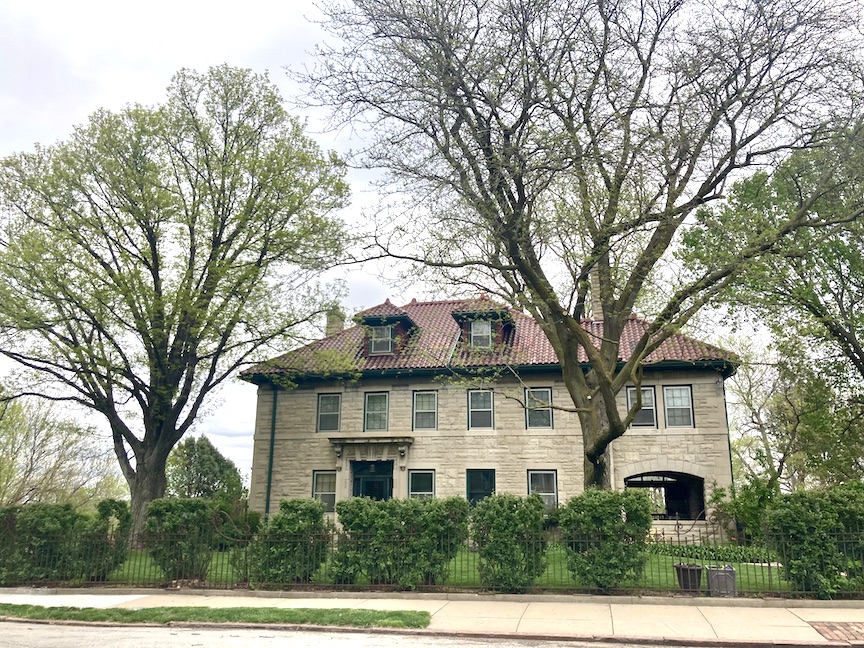
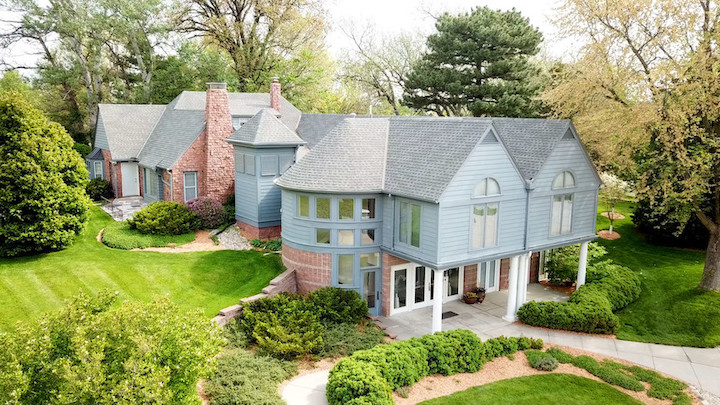
Oh, my heavens. The amount of research and interest is quite overwhelming. Keep up the amazing history-making work.
]
Thank you!
I know this isn’t the correct way to reach you about this particular subject, but I couldn’t figure out another way, so here goes:
I believe the title was Omaha Delights…something like that. You mentioned the home at 5102 California St. We lived there from 1976 until 1996. A commercial for Lifesavers candy was filmed at our house in 1978, starring Henry Fonda. He came to the front porch and we spoke briefly. He grew up in the house next door he told me. It was pretty exciting! The commercial was only aired a few times, starting in January of 1979, and shortly after that, Mr. Fonda died. We had no way to record it in those days! My son (who I was pregnant with while the commercial was being filmed) found a copy of the commercial for me.
Thought you might want to know!
Kathleen Hahn You can’t control the wind, but you can control the sails.
________________________________
I do want to know! You are correct. This is fascinating.I have heard stories of Henry Fonda living in Omaha as a child. Wow…so he really was that personable. So cool. Thank you for sharing. Sorry it’s so hard to sift through the site and connect this comment w Delights of Omaha. Hoping to fix that. Take care
KatyRae – I hope you like what I’ve found.
Go to: https://www.youtube.com/watch?v=RtZNfl88YU8
Scroll ahead to 5:18
What a FUN blog.
Oh I love it! I dont think I remember that ad. Fantastic. Good detective work.
Your blog is great!! Can you find a way to put a menu or directory at the beginning? It would really help to find subjects/topics in a timely manner. Thanks!
Hello and thank you! Yes, it is frustrating, isn’t it. This became apparent to me at about week two. I have met w a blog designer months ago and am awaiting his work. Please don’t give up on me. When he completes this design, I will be so happy. It should be much easier to navigate. Thanks for the feedback.
I am trying to do this for my own home… I would love to pick your brain sometime to find out how to do this!
Hi–email me at myomahaobsession@yahoo.com and we’ll chat.
The Dictograph devices throughout your house are part of a Fire Alarm system. The Dictograph Products, Inc., of 580 Fifth Avenue, New York 19, N. Y., produced fire alarm systems which they have named the “Fire Detective”. I have the same devices throughout my house as well. It was not an eavesdropping monitoring device as you stated in your blog.
Just wanted to let you know that while I happened on this accidentally, once I started reading I could not stop.
Although I have lived close to this area for almost 55 years and have probably driven past that house easily hundreds of times I had no idea of the amazing history. I will pay special attention on my next drive past.
Thank you for a very fascinating read!